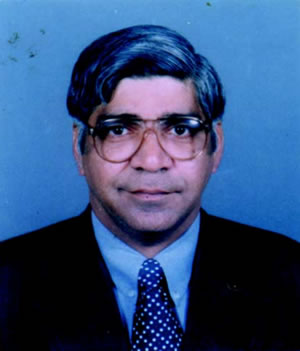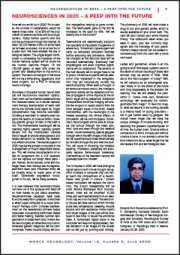Original article published 23 May 2000 in World Neurology Vol 15 No.2 from extracts from the lecture delivered by Prof. K. Ganapathy,by Prof. K. Ganapathy, at the 10th Asian and Oceanian Congress of Neurology held in Manila, January 22–26, 2000.
 |
Prof. K. Ganapathy |
How will our world be in 2025? For a starter, the number of centenarians would be twenty times more. 15 to 20% of the population of several countries will be octogenarians. Today human sperms and ova can be purchased through the Internet. At least 120,000 babies in the US alone have so far been produced, not on a bed but in a petri dish. We have entered the era of designer babies. The single largest contribution to unravelling the mysteries of the human nervous system will no doubt be the Human Genome Project. Of the 130,000 genes at least 30% direct the growth and development of the nervous system. The neuro-oncologist of the future will not be a knife-toting, aggressive skull base surgeon, but a PhD in molecular neuro-oncology.
Discovery of the adult human neural stem cell will revolutionise treatment options. Stem cells can be injected stereotactically into diseased areas, as a cellular replacement therapy. Manipulation of stem cells will be the ultimate body repair kit. Organ transplantation may become redundant. Growing a new brain is certainly even beyond the realms of science fiction. Growing specific groups of cells in the brain is not. The interventional neurologist will be injecting highly specific capillary growth factors into the thrombosed cerebral blood vessel to ensure angiogenesis and revascularisation to reverse the deleterious effects of stroke. The neurosurgeon of 2025 may be the primary consultant in the management of insulin-dependent diabetes. This will involve transplantation of islets of Langerhans into a CSF reservoir. Can we replace our body? Most parts – yes. Nerves, blood vessels, bone and cartilage, heart, liver, kidneys can be regenerated from stem cells. Prosthetic limbs will be directly wired to motor parts of the brain. Genetically engineered tissue, grown in the lab, will be freely available. It is now believed that neurotransmitters can leak out of the synapse and head off on their travels to just about anywhere. Neurotransmitter receptors have been found far away from synapses. Is the brain a wired super computer or a super pharmacy? Perhaps both! Complex craniotomies on the exteriorised primate foetus have been successfully performed. Better and faster healing, besides quicker reorganisation in foetal brain cells, makes foetal neurosurgery an attractive proposition. Antenatal genetic diagnosis will be commonplace. Foetal muscle biopsy will confirm myopathies leading to gene correction. The Methuselah gene in the fruit fly increases its life span by 35%. Will we identify this in the human?
Telemedicine will electronically transport the specialist to the patient irrespective of where he is. Tomorrow's cybersurgeon will carry out advanced simulation routinely before executing any procedure. Electrical changes at the neuronal level will be recorded telemetrically. Eventually their physiological and even cognitive significance will be understood. The terrorist of the next decade will no longer have to be in prison. He will be on parole with an electronic chip implanted in the amygdala.
This chip will continuously monitor the electrical activity. When even a thought of an antisocial nature occurs, the change in electrical activity will be detected and further propagation of the impulse to the effector organ will be prevented. Advanced intraoperative functional imaging will enable the surgeon to resect lesions from the most eloquent areas of the brain. Awake craniotomies, with the neurologist in the theatre evaluating the clinical effects of stimulation, will be commonplace. Tomorrow's neurosurgeon will be able to visualise the tumour through the intact skin, skull, dura and even through the cerebral cortex. He will be wearing special goggles through which the MRI image of the lesion will be superimposed three-dimensionally as he looks through the skin over the skull. This will result in choosing the smallest opening. Frameless stereotaxy will eventually replace frame-based stereotaxy.
Craniotomies of the twentieth century will gradually fade into oblivion. The computer in 2025 will have biological signal sensors with in-built thought recognition software. A computer chip can never reach the compactness of a neuron. Nerve cells grown in culture / protein based computers will replace the silicon chip. The body's bioelectricity will be used. Minute discharges from muscles, nerves, brain will be amplified 10,000 times and sent telemetrically from an electronic cap worn on the head. The electronic mouse will have sensors which monitor pulse rate, temperature, sweating, muscle tension and skin resistance. Voice imprint and visual images of the user will be analysed in real time, to reveal the emotional state. A humanised digital voice in the computer will respond appropriately. Tactile sensation of an image on the screen can be felt just by pointing and clicking. The pharmacy of 2025 will tailor-make a drug to suit your genetic profile, which is readily available on your smart card. This card will also contain your entire medical history. The ultrasound taken when you were in utero, your last coronary angiogram and the histology of your grandmother's breast cancer can be viewed instantaneously from this card with a voice command.
Ladies and gentlemen, where is all this going to end? Will expert systems result in the death of clinical neurology? Many wild animals may be extinct in 2025. What about the neurosurgeon of today? Well, he will certainly be an endangered species! Many of us are afraid of the future and cling desperately to the present not realising that we are already the past. Arthur C. Clarke once said, "Advanced technology will eventually be indistinguishable from magic". To face this magic, what we require in the coming decade is a mature head on young shoulders – not to get carried away by gadgets. We should never forget that we have the unique privilege of trouble-shooting and repairing the greatest supercomputer of all time, the human brain. Science without compassion is blind; compassion without science is lame. In our anxiety to enter the third millennium let us never forget that we are healers first and technologists later. ■
At time of print, Prof. K. Ganapathy was Secretary General, Asian Australasian Society of Neurological Surgery and Secretary, Neurological Society of India








